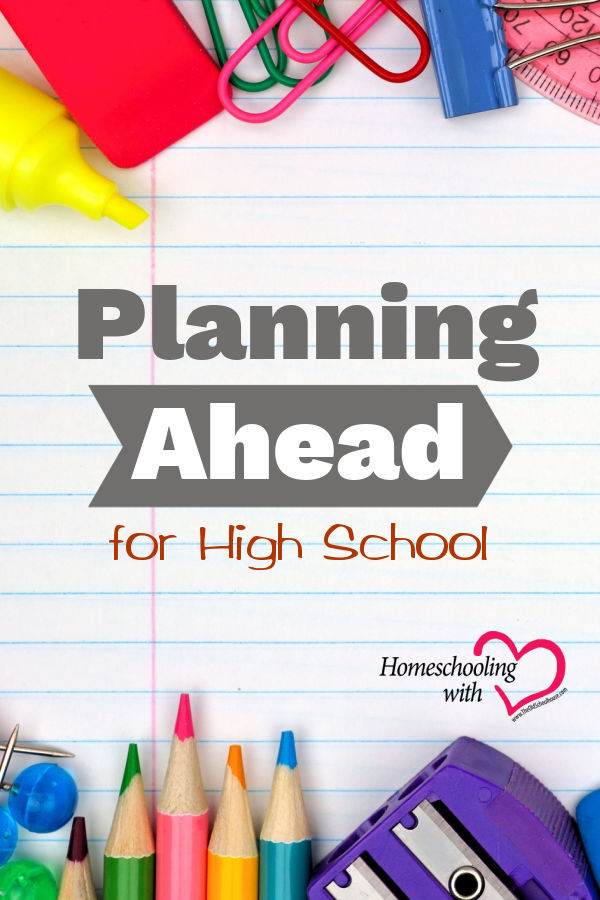Planning Ahead for High School


High School. These words often cause increased heart rates and furrowed brows. What if you forget to include a needed class, miss important dates, or fail your child in some other way? Granted, the high school years are the most important years in regard to preparing your student to be successful, responsible, and independent after graduation. Although there is reason for concern, planning ahead can ensure your child’s success (assuming they cooperate with your plans) and, in turn, relieve much anxiety. So, let’s talk about what needs to be done to make sure you cover all of the bases that need to be covered. At the end of this article, I will include a suggested timeline for the high school years.
Courses and Curriculum: First let’s talk about basics, and then let’s talk about the courses that are often overlooked but, in my opinion, may be more important than some of the core classes. Each state has a set of recommended guidelines for classes that are to be included in high school. Generally, this list will include a variety of electives and core classes such as English, social studies, science, history, math, and foreign language. Many states have now added personal finance as a core class (which makes so much sense). The number of credits required for graduation varies with a minimum of 16 to 24 depending on the state. This article provides a summary of each state’s requirements. In most states, the requirements are suggestions for homeschoolers; however, there may be particular requirements in regard to courses and exam scores that homeschoolers must meet in order to qualify for state grants. Do a little research in order to find out expectations in the state where you live. Also, be aware that certain colleges have expectations in regards to high school classes completed during high school. Some require two years of the same foreign language and others do not. Although your students may have no idea of what they want to study in college before they entire high school, it is a good idea to have top college choices narrowed down before the junior year, if possible, so that you will be aware of each college’s expectations.
Now let’s talk about those often-overlooked classes. Granted, we want our students to be prepared academically, but we also want them to be able to be well rounded and confident. In the past, personal finance classes were rarely offered to high school students. Fortunately, that is changing. In addition to personal finance, additional classes to consider are current events, logic, speech, debate, entrepreneurship, and apologetics. There are several Christian speech and debate clubs for homeschooled students. If you can find a club in your area, check it out. Regrettably, my oldest four did not take debate in high school, but it became a non-negotiable mandate for their five younger siblings.
One more piece of advice in regard to class choices: if your student already knows what they want to major in, then they can design their schedule around classes that will better prepare them for that major. For instance, students interested in engineering should have a heavy concentration of both science and math classes.
Classes for College Credit: High school students have the option of taking college classes while in high school. Because they receive both college and high school credit, this is called dual enrollment. The guidelines for dual enrollment vary according to state and to participating colleges. Most colleges allow students to take classes after they have completed the tenth grade, but that varies as well. In some states dual enrollment is free while in other states there are grants that cover a certain number of classes, and in many states, there are no discounts or options for dual enrollment. However, colleges may have dual enrollment discounts and scholarships. I am the Homeschool Specialist at Bryan College, and we offer a $200 scholarship for out-of-state students for each dual enrollment class. Students who live in Tennessee can receive the same scholarship after they have used the Tennessee DE grant which pays for 2 ½ classes at Bryan College. Most homeschoolers give their students a full year credit for a three-hour college class. There are advantages to dual enrollment, but there are dangers as well as mistakes to avoid. When your students choose which college classes to take, they need to be aware that the four-year plan for an engineering, or a pre-professional degree, will look different than the four-year plan for a liberal arts degree. If they do not have a major in mind, then taking basic classes such as English, math, science and history may be the ‘safest’ classes to take so that the credit will count towards the students’ degree.
Testing: If you have not had your student take tests before high school, it is time to begin doing that. Even though, because of COVID, many colleges are test optional at this time, many still require college exam scores for admission and scholarship. The colleges that are test optional are not test blind, meaning they will look at exam scores when supplied. In addition to colleges requiring test scores, exam scores are required for homeschooled students to qualify for state grants in certain states, even during the pandemic. Not requiring my older children to take tests is one of the regrets I have, and you can read more about that, as well as other common mistakes often made by homeschoolers, here. Middle school students can begin taking the CLT 8 online. Ninth and tenth graders can take both the CLT10 (offered several times a year, at home, no charge) as well as the PSAT. The score from the PSAT is used to determine National Merit Scholars (NMS). Even a semi-finalist receives full tuition from Bryan College. Although 9th and 10th graders can take the PSAT, it is the score from a student’s junior year that counts towards the NMS. It is an affordable test offered in October and January. If a student cannot find a location to take the PSAT during COVID, there is a way to take the SAT and have it count as the PSAT. During the last two years of high school your students should take at least one, and perhaps all three, of the college exams in order to see what they are like, and to find out which one they are most comfortable taking. Once they determine that, they can continue taking these tests up until they enter their first semester of college because, when used to determine merit award amounts, the better the score, the higher the scholarship.
Transcripts: If you are signed up under an umbrella school, they will provide you with a transcript. If you plan to create your students’ transcripts, be sure to keep records of the classes your students take along with the grades they earn (beginning with 9th grade). If you would like to receive a free, editable template for a transcript, I will be glad to email you one upon request (pat.wesolowski@bryan.edu). The transcript template is also included in a free e-resource that can be downloaded here (scroll down the page). Most colleges accept a transcript created by homeschool parents. You must sign the transcript. Some colleges may require you to have the transcript notarized. Generally, transcripts include the students’ personal information (address, date of birth), title of the classes taken, credits earned, the grade assigned, and the GPA. You also must include a school name, and it can be something as simple as your last name or your street name, followed by the word school or academy. Some colleges require that transcripts include codes (SCED). SCEDs can easily be found by doing a google search. Students planning to play sports with NCAA eligibility will have to provide more information on their transcripts. This Facebook group is a great place to find answers to your questions and support in this regard.
Additional Opportunities: Your students will, more than likely, participate in activities such as sports, band, dance, etc. They may attend camps, conferences, and join clubs. There are several Christian speech and debate leagues, Civil Air Patrol, TeenPact, Generation Joshua, and additional programs that many homeschooling families take advantage of during the high school years. Many high school students volunteer to work with local ministries and organizations. Keep a record of their hours. Community service hours are often required in order to qualify for particular state grants and scholarships. An easy way to organize records is to put certificates, commendations, or anything else that corroborates your student’s activities in page protectors inside a three-ring notebook. Attending camps offered on college campuses are a great way for students to confirm interest in a college, meet likeminded friends who may be potential roommates, learn their way around campus, and earn a little bit of college credit.
Timeline of events:
Pre-high school – Research opportunities and requirements for homeschooled students in your state/city.
9th Grade – Take the PSAT in October and January as practice. Take the CLT10 as many times as offered. Complete courses to earn approximately 6 hours of credits. Set up a transcript form and begin entering information pertaining to classes, credits earned, and GPA.
10th Grade — Take the PSAT in October and January as practice. Take the CLT10 as many times as offered. Complete courses to earn approximately 6 hours of credits. Begin looking at colleges in order to narrow down top choices; find out admission requirements and scholarship possibilities. Look into dual enrollment opportunities and research dual enrollment grants in your state.
11th Grade – Take the PSAT to qualify for National Merit Scholarship. Take the CLT, ACT, and/or SAT. Begin dual enrollment classes. Visit college campuses. Research state grants in order to find out qualification requirements for homeschool students. Talk to college coaches and faculty members about scholarships for music, theater, athletics, etc. in order to arrange auditions and try-outs.
Summer before 12th Grade – Apply to top college choices if possible, ask about fee waivers, and attend camps offered on the campuses of top college choices.
12th Grade – Finalize credits needed for graduation, continue with dual enrollment classes, continue taking ACT/SAT/CLT if higher scores are needed for admission and/or scholarships, apply to top college choices if that has not yet been done, fill out the FAFSA on, or soon after, October 1st. Find out if there are scholarship opportunities for seniors that take place on the campus of top college choices. Students interested in music and theater programs should arrange auditions and athletes should arrange try-outs.
Summer after 12th Grade – Continue with dual enrollment classes of possible, attend camp on top college choice campuses, continue taking ACT/SAT/CLT if higher scores are needed, finalize transcript.
Pat Wesolowski is an author, speaker, and homeschooling mother of 9 who is now the Homeschool Specialist at Bryan College in Dayton, TN. After homeschooling her 9 children for the past 32 years, she is finally finished! Pat has a heart for helping parents find joy in their homeschooling experience and, for that reason, loves teaching workshops in order to encourage and equip parents for a fun and successful homeschool experience. Pat is the host of a podcast entitled “Homeschooling Co-op Style,” writes a blog, and has authored numerous unit studies for homeschooled students. Pat has also written a free eResource to help parents plan for a successful high school experience. It is available to download at this link: www.bryan.edu/ebook.













































